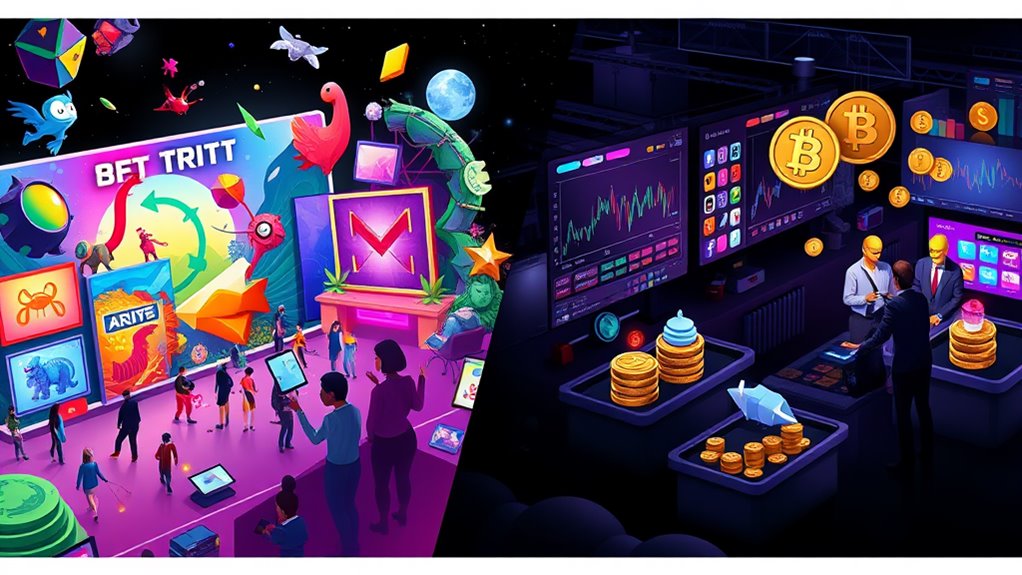
NFTS Vs Cryptocurrencies: What’s the Difference?
NFTs and cryptocurrencies are distinct digital assets with unique purposes and characteristics. NFTs, or non-fungible tokens, represent ownership of unique items and cannot be divided or exchanged on a one-to-one basis. In contrast, cryptocurrencies, like Bitcoin, are fungible, allowing them to be divided and used for transactions. The value of NFTs relies on rarity and creator reputation, while cryptocurrencies depend on market dynamics. Exploring further reveals more about their trading platforms and future potential.
Key Takeaways
- NFTs are unique digital assets representing specific items, while cryptocurrencies are fungible digital currencies used for transactions.
- NFTs are indivisible and represent ownership of unique items, whereas cryptocurrencies can be divided into smaller units.
- The value of NFTs is determined by rarity and creator reputation, while cryptocurrencies are influenced by supply, demand, and market sentiment.
- NFTs are primarily used in art, gaming, and music, while cryptocurrencies facilitate trade and secure international transactions.
- NFT marketplaces typically operate on decentralized platforms, while cryptocurrency trading occurs on centralized exchanges like Binance and Coinbase.
Definition and Purpose of NFTs and Cryptocurrencies

In the evolving landscape of digital finance, understanding the distinctions between non-fungible tokens (NFTs) and cryptocurrencies is vital.
NFTs are unique digital assets that signify ownership of specific items, ranging from artwork to event tickets. Each NFT is stored on a blockchain, which guarantees its security and authenticity through unique identification codes.
NFTs represent exclusive digital ownership, whether for artwork or event tickets, secured by unique identification codes on the blockchain.
In contrast, cryptocurrencies, such as Bitcoin and Ethereum, function as digital currencies designed for transactions. They utilize cryptography for security and serve primarily as a medium of exchange.
While NFTs focus on proving ownership and authenticity of unique digital and real-world assets, cryptocurrencies aim to facilitate transactions and provide a decentralized alternative to traditional currencies, promoting financial inclusivity across various networks. NFTs are created through a process called minting, where digital assets are encrypted and recorded on a blockchain.
Key Characteristics: Fungibility and Divisibility

Fungibility and divisibility are key characteristics that distinguish cryptocurrencies from non-fungible tokens (NFTs).
While cryptocurrencies, such as Bitcoin, are interchangeable and can be divided into smaller units, NFTs represent unique assets that cannot be split or exchanged on a one-to-one basis.
This fundamental difference impacts ownership models, where NFTs can allow for fractional ownership, enabling multiple parties to invest in a single digital asset. By enabling fractionalized NFTs, the market can enhance accessibility and liquidity, making high-value NFTs more affordable and tradable.
Unique Versus Interchangeable Assets
Understanding the differences between unique and interchangeable assets is crucial in the domain of digital finance. Non-fungible tokens (NFTs) are distinct assets, each possessing unique identifiers that guarantee no two tokens are the same. This uniqueness makes NFTs ideal for representing collectibles or exclusive digital items.
In contrast, cryptocurrencies are fungible, meaning each unit can be exchanged for another of the same type without loss of value. This interchangeability allows for easier trading and broader applications as mediums of exchange.
Additionally, NFTs are indivisible, maintaining their unique qualities as whole entities, whereas cryptocurrencies can be divided into smaller units. These characteristics highlight the fundamental differences in how NFTs and cryptocurrencies function within the digital economy. Furthermore, the blockchain ensures security of these transactions, providing proof of ownership and authenticity for NFTs.
Whole Versus Fractional Ownership
How does ownership differ between whole and fractional assets in the digital domain? In the context of cryptocurrencies and NFTs, this distinction is significant.
Cryptocurrencies are fungible, allowing for complete ownership of divisible units, meaning users can own a fraction of a coin. Conversely, NFTs are non-fungible and indivisible, representing whole digital assets, which makes partial ownership challenging.
However, fractional ownership of NFTs is being explored through new platforms, enabling multiple individuals to hold a share of the asset’s financial interest. This method does not split the digital asset itself but rather distributes the associated rights.
Consequently, while cryptocurrencies facilitate easy transaction and division, NFTs focus on unique ownership, with emerging solutions for shared investment opportunities. As the market evolves, utility NFTs are expected to provide additional benefits that enhance their appeal for fractional ownership.
Market Presence and Value Comparison

The market presence of NFTs and cryptocurrencies reflects distinct characteristics and trends.
While cryptocurrencies operate in a larger, more established market primarily focused on transactions, NFTs have emerged as a unique asset class with varying value determinants such as rarity and demand.
Recent fluctuations in both markets highlight their popularity trends, with NFTs experiencing significant growth alongside challenges that could impact their future stability and market size. Additionally, the expected growth of the NFT market in 2025 emphasizes the evolving landscape and increasing interest in these digital assets.
Market Size Overview
In recent years, the market presence of NFTs has shown remarkable growth, reflecting a significant shift in the digital asset landscape.
The global NFT user base is projected to reach approximately 11.6 million by 2025, driven by increasing popularity in collectibles and gaming.
The NFT market is expected to expand from around $43 billion in 2024 to $61 billion in 2025, demonstrating a 41.6% increase.
Long-term projections suggest the market could reach $247 billion by 2029, with a compound annual growth rate (CAGR) of about 30%.
Meanwhile, cryptocurrencies maintain a larger overall market size, with Bitcoin and Ethereum as dominant players.
This comparison highlights the distinct yet evolving roles of NFTs and cryptocurrencies in the digital economy.
Value Determinants Explained
While both NFTs and cryptocurrencies play significant roles in the digital economy, their value is determined by different factors that reflect their unique characteristics.
NFTs derive value from rarity, scarcity, and the reputation of their creators. Unique artworks or collectibles gain higher valuations, especially if they commemorate significant events or offer additional utility. This is particularly evident in the music industry, where music NFTs empower artists and foster deeper connections with fans.
In contrast, cryptocurrencies are primarily driven by supply and demand dynamics, adoption rates, and market sentiment. Their value fluctuates based on how widely they are accepted as payment and the security of their underlying technology.
Additionally, regulatory environments can impact the perceived stability and trust in cryptocurrencies, highlighting the contrasting value determinants between these two digital assets.
Popularity Trends Analysis
Frequently, the popularity trends of NFTs and cryptocurrencies reveal distinct patterns that reflect their market presence and value comparison. The NFT market peaked in 2021, generating $25 billion in sales but has since declined. In contrast, cryptocurrencies maintain a strong presence, largely due to their inherent volatility and connection to NFTs. The following table summarizes key trends:
| Category | NFTs | Cryptocurrencies |
|---|---|---|
| Peak Sales Year | 2021 | Ongoing |
| US Market Share | Largest audience | Dominant force |
| Recent Sales Value | $1.2 billion (2023) | High volatility |
| Ownership Demographics | 4% of US adults | Varied |
| Global Interest Growth | India, China, Brazil | Worldwide |
As the metaverse expands, the ownership of virtual land NFTs offers users new avenues for investment, creativity, and community building within these immersive digital landscapes.
These trends illustrate the evolving dynamics between NFTs and cryptocurrencies, highlighting their unique positions in the digital asset landscape.
Applications and Usage Scenarios

NFTs are primarily applied in fields like art and gaming, allowing the secure representation of ownership for digital artworks and in-game assets. In music, artists leverage NFTs to tokenize their work and generate royalties. Real estate also benefits, as NFTs can signify ownership of properties. Additionally, NFTs are impacting supply chain management by enhancing product authenticity and tracking.
On the other hand, cryptocurrencies serve as a medium for trade, facilitating quick and secure transactions internationally. They are also used for investments, offering high-risk opportunities for potential returns. Additionally, cryptocurrencies support financial inclusion by providing access to financial services for those without traditional banking.
Both technologies share blockchain foundations, enhancing security and transparency across their applications.
Creation and Minting Processes

The creation and minting processes for NFTs and cryptocurrencies are essential to their existence and functionality. Both rely on blockchain technology, enabling the secure creation and management of digital assets.
Cryptocurrencies are fungible, meaning each unit is interchangeable, while NFTs are non-fungible, making each token unique. The minting of NFTs involves uploading digital content and creating a distinctive token, often incurring gas fees that vary by network.
In contrast, cryptocurrency minting generates new units through validation by network participants. Smart contracts play an important role in both processes, ensuring ownership and transferability. Additionally, the process of NFT minting allows creators to establish ownership authenticity through blockchain technology, enhancing the value of their digital assets.
While both assets are stored digitally, they require secure storage due to their inherent value, emphasizing the significance of safeguarding these digital investments.
Trading Platforms and Marketplaces

While both NFTs and cryptocurrencies are traded on various platforms, the nature of these trading environments differs considerably due to the unique characteristics of the assets involved.
Cryptocurrency trading occurs mainly on centralized exchanges like Binance and Coinbase, focusing on financial transactions. In contrast, NFT marketplaces, such as OpenSea and Rarible, often operate on decentralized platforms. These marketplaces cater to unique digital assets, including art and collectibles, often using blockchain for ownership verification. Additionally, platforms like OpenSea support multiple blockchains, enabling users to explore a wider range of NFTs across various ecosystems.
The user interfaces differ as well; NFT platforms display detailed artwork, while cryptocurrency platforms prioritize simpler transaction processes.
Furthermore, market dynamics vary, with cryptocurrencies affected by financial trends and NFTs driven by art and gaming trends, highlighting their distinct trading ecosystems.
Security Risks and Challenges

In the evolving landscape of digital assets, security risks and challenges present significant concerns for both NFTs and cryptocurrencies. Hacking incidents, such as those experienced by Nifty Gateway, highlight vulnerabilities due to inadequate security measures.
Both rely on blockchain technology, which can be exploited through smart contract flaws or phishing scams. Wallet security remains a critical issue, as poor management can lead to asset loss. User errors, including neglecting two-factor authentication, further increase the risk of account breaches.
Additionally, phishing attacks, rug pulls, and fake marketplaces pose threats, particularly to inexperienced buyers. As digital assets gain popularity, understanding these security challenges is essential for protecting investments and ensuring safer transactions in the NFT and cryptocurrency markets.
Future Outlook for NFTs and Cryptocurrencies

Emerging from discussions about security risks, the future outlook for NFTs and cryptocurrencies presents a landscape marked by growth potential and evolving applications.
The NFT market is projected to reach $608.6 million by 2025, driven by mainstream adoption and innovative use cases, such as gaming and digital membership.
In contrast, the cryptocurrency market, larger with over 4,000 varieties, faces regulatory challenges but continues to expand.
Blockchain technology remains central to both sectors, enhancing security and scalability.
As investors diversify portfolios, volatility persists, influenced by market interest and scarcity.
Frequently Asked Questions
Can I Convert NFTS Into Cryptocurrencies Easily?
Converting NFTs into cryptocurrencies can be accomplished through platforms like OpenSea, but the process is influenced by market demand, transaction fees, and specific blockchain support, making it not always straightforward or easy.
What Are the Environmental Impacts of NFTS and Cryptocurrencies?
The environmental impacts of NFTs and cryptocurrencies include significant energy consumption, carbon emissions, and e-waste generation. Both sectors are exploring renewable energy solutions and energy-efficient mechanisms to mitigate their ecological footprints and promote sustainability.
Are NFTS Considered a Good Long-Term Investment Strategy?
Despite concerns over volatility, NFTs can be a viable long-term investment if selected based on uniqueness and demand. Their potential for significant returns, coupled with community support, enhances their attractiveness within a diversified portfolio.
How Do Taxes Apply to NFT and Cryptocurrency Transactions?
Taxes on NFT and cryptocurrency transactions involve capital gains tax, with rates varying based on holding duration. Unique NFTs may incur higher collectible tax rates, necessitating diligent reporting and potential professional guidance for compliance.
Can NFTS and Cryptocurrencies Be Used Together in Projects?
NFTs and cryptocurrencies can indeed be used together in projects, leveraging blockchain technology for transactions. Their integration enhances market functionality, allowing unique digital asset representation while facilitating financial interactions and investment opportunities.
Conclusion
In conclusion, NFTs and cryptocurrencies serve distinct purposes within the digital economy. While cryptocurrencies like Bitcoin are designed for transactions and value storage, NFTs represent ownership of unique digital assets. An interesting statistic highlights this difference: as of 2023, the NFT market generated over $24 billion in sales, showcasing its unique appeal. Understanding these differences is essential for traversing the rapidly evolving landscape of digital assets, where each serves a specific role and audience.












